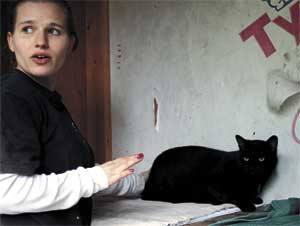Feral cats living at American Camp had better watch out.
Starting Feb. 19, the Animal Protection Society and the Ray of Hope Animal Sanctuary will inaugurate a joint program with the National Park Service to first trap, and then spay or neuter, feral cats at American Camp. The program —- dubbed as “experimental” for now — may be expanded to English Camp at a later date, according to park Superintendent Lee Taylor.
“Our ultimate objective is to reduce the feral cat population to zero throughout the park in a humane manner,” Taylor said. “This approach is experimental and may take several years.” The lifespan of feral cats is estimated at three to five years, according to Taylor.
Taylor said feral cats have been observed for many years in both English and American camps; she estimated that ten feral cats live permanently in American Camp, with others just outside the boundaries. Many are the offspring of abandoned pets. It is unlawful to leave any animal in a national park, she said.
The park will utilize “Have A Heart” traps that weigh about 17 pounds apiece. Ray of Hope will provide the traps; the Animal Shelter through a grant will pick up funding for sheltering, surgeries and vaccinations.
The trapped cats will be examined, spayed or neutered, vaccinated and, if determined to be inappropriate for adoption, returned to the park. They also will be tested for feline aids and leukemia as a safeguard to domestic cats in the area.
Tens of millions of feral and stray cats are reported throughout the United States. A blog by Russell McLendon on Mother Nature Network estimates that cats kill as many as four billion wild animals per year and, worldwide, have pushed 33 species to extinction. Other research suggests that about 40 per cent of all animals killed by domestic and feral cats are birds.
The neutered cats will have their ears “tipped”, a procedure that involves removing about a quarter inch off the tip of the cat’s ear while it is anesthetized during the TNR process. As time passes, ear-tipping will help distinguish between ferals and strays, avoiding unnecessary surgery, confinement, or euthanasia.
Not everyone is onboard with all aspects of the program. The San Juan Island chapter of the Audubon Society objects to returning the feral cats to the outdoors, but Taylor said the program would begin next week as planned unless she is instructed otherwise by the National Park Service.
Barbara Jensen of the Audubon Society, also a cat owner, says the best solution is a public education program to convince cat owners not to abandon their pets. Jensen points out that pet abandonment is cruel and inhumane: many cats die of starvation or are killed, and the survivors live short, difficult lives.
Taylor agrees. “The best way, obviously, to treat this problem is not to abandon a pet in the park,” Taylor said. “If this humane approach doesn’t work, then we may have to consider other options.”



